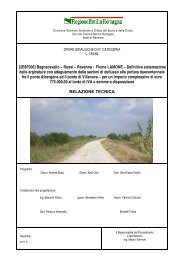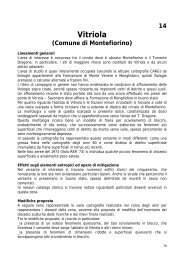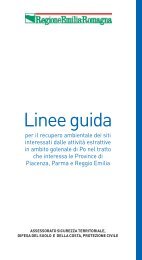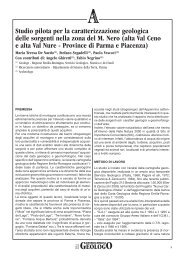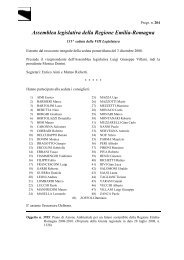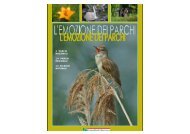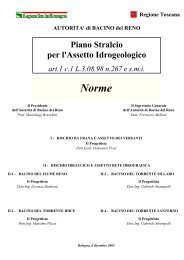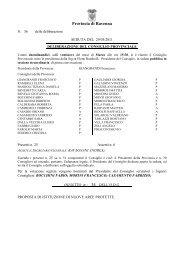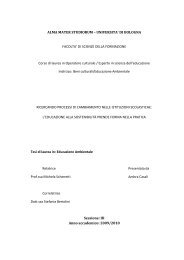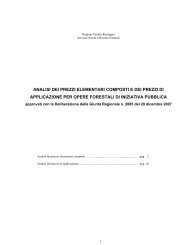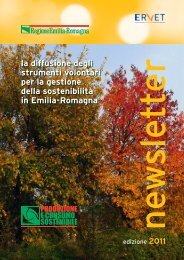air, water and soil quality qualité - ER Ambiente - Regione Emilia ...
air, water and soil quality qualité - ER Ambiente - Regione Emilia ...
air, water and soil quality qualité - ER Ambiente - Regione Emilia ...
You also want an ePaper? Increase the reach of your titles
YUMPU automatically turns print PDFs into web optimized ePapers that Google loves.
Results<br />
The oxygen <strong>and</strong> hydrogen isotope ratio on rain<strong>water</strong> (reported as 18 O- D values,<br />
which represent the ‰ deviations with respect to the st<strong>and</strong>ard mean oceanic <strong>water</strong><br />
SMOW allowed a first construction of a local meteoric <strong>water</strong> line, given by D =<br />
7.47* 18 O+9.70. Superficial-<strong>water</strong>, ground-<strong>water</strong> <strong>and</strong> <strong>water</strong>s in <strong>soil</strong>s have 18 O <strong>and</strong><br />
D values in the range -8.53‰ ÷ -0.69‰ <strong>and</strong> -60.1‰ ÷ -5.8‰, respectively; it has<br />
to be noted that <strong>water</strong>s from the deeper piezometers are characterized by less<br />
negative values with respect to the shallower ground-<strong>water</strong>s. Waters in <strong>soil</strong>s cover<br />
a wide range of isotopic compositions. Some of these <strong>water</strong> samples show an<br />
isotopic shift towards the meteoric <strong>water</strong> line following events of heavy rain,<br />
suggesting the direct contribution of precipitation by infiltration. The <strong>water</strong><br />
channels which supply fresh<strong>water</strong> are characterized by the most negative isotopic<br />
composition with respect to all the remaining samples. The Sr isotopic<br />
composition, expressed by the 87 Sr/ 86 Sr ratio, is in the relatively narrow range<br />
between 0.70872 <strong>and</strong> 0.70935, with most samples clustering to 0.7091, a value<br />
which is close to what measured in sea<strong>water</strong> at Pialassa Baiona lagoon.<br />
In superficial-<strong>water</strong>, ground-<strong>water</strong> <strong>and</strong> <strong>water</strong>s in <strong>soil</strong>s 11 B ranges between +5.7‰<br />
<strong>and</strong> +38.6‰; the higher values approach the composition of Mediterranean<br />
sea<strong>water</strong> <strong>and</strong> are recorded by the deeper piezometers <strong>and</strong> some of the <strong>soil</strong> <strong>water</strong>s.<br />
Discussion <strong>and</strong> conclusions<br />
In the 18 O vs. D diagram (Fig. 1), the <strong>water</strong> samples define a straight line which<br />
deviates from the local line of precipitations, <strong>and</strong> is interpreted as the progressive<br />
mixing between fresh<strong>water</strong>s, as defined by the Apennine catchments, <strong>and</strong> sea<strong>water</strong>.<br />
A first modeling quantifies the sea<strong>water</strong> contribution as about the 70-90% <strong>and</strong> 30-<br />
60% for the <strong>water</strong> bodies sampled by the deeper <strong>and</strong> shallow piezometers,<br />
respectively. The contribution of the marine component for most <strong>water</strong>s from <strong>soil</strong>s<br />
would be in the relatively limited range between 40-50%, with the exception of two<br />
samples from the northern side of the area, reaching the 75-80%. The 11 B<br />
correlates with 18 O (Fig. 2) in ground- <strong>and</strong> <strong>soil</strong>- <strong>water</strong>s. A mixing at different<br />
degrees of the recharging fresh, low-B <strong>water</strong> (Lamone river–type) with sea<strong>water</strong><br />
could explain the observed 11 B variation. However, in the Northern sector of the<br />
Pineta di San Vitale boron characteristics in <strong>soil</strong> <strong>water</strong> diverge from the main<br />
fresh-sea<strong>water</strong> mixing trend.<br />
More complex processes are needed to explain the isotopic composition of the<br />
Pialassa Baiona <strong>water</strong>s; as also suggested by the observed range in the 87 Sr/ 86 Sr<br />
ratio (Fig. 3) that indicates the contribution from different sources to the Sr budget.<br />
These processes involve cation exchanges with the solid phase triggered by<br />
sea<strong>water</strong> intrusion, the role of organic matter <strong>and</strong> anthropogenic sources.<br />
<br />
40



